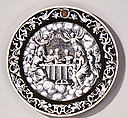The Wedding Feast of Cupid and Psyche
Enameler Pierre Reymond
After an engraving of 1532 by the Master of the Die Italian
Not on view
The subject of this plate is an episode in the tale of Cupid and Psyche from Book V of The Golden Ass by the Latin author Lucius Apuleius (born 125 A.D.). The winged god of love, Cupid, is customarily depicted by Renaissance artists as either an infant or a youth, but in the scene on this plate, the child Cupid incongruously stands at the knee of his adult bride who is seated with other gods and goddesses at a long table presided over by winged personifications of the hours. Like the Sacrifice of Noah, the Wedding Feast of Cupid and Psyche is based on an original composition by the High Renaissance Italian artist Raphael. The scene appears as part of a cycle of frescoes on the ceiling of the Sala de Psiche at the Villa Farnesina in Rome, painted ca. 1518 by two of Raphael's assistants, Giulio Romano (1499–1564) abd Giovanni Francesco Penni (1496–1528), from designs by Raphael. A variant copy of the fresco was made by the Master of the Die, an anonymous Italian engraver active about 1532. For some reason, the engraver substituted the infant cupid for the handsome youth in the fresco. Reymond's dish is a faithful copy of the engraving. The fantastic figures that cavort around the rim of the plate are also Italian in origin, and they ultimately derive from antique Roman wall decoration.
This plate is one of a pair in the Museum's collection with the same coat of arms. The other plate (04.6.8) illustrates the Toilet of Psyche and is dated 1570.
Due to rights restrictions, this image cannot be enlarged, viewed at full screen, or downloaded.
This artwork is meant to be viewed from right to left. Scroll left to view more.



